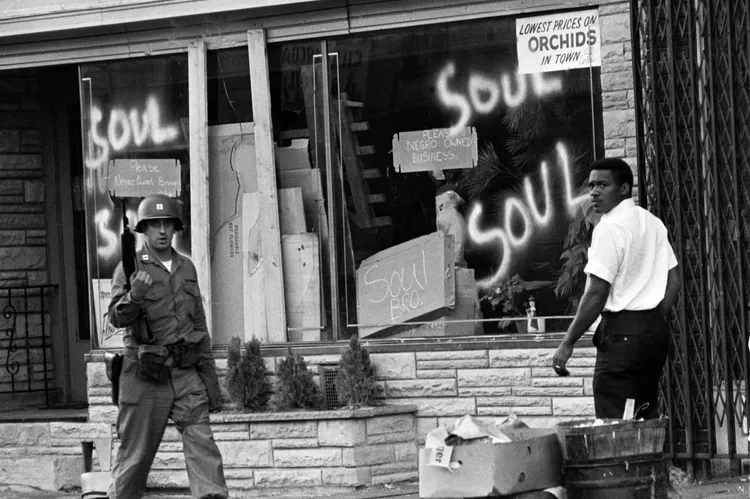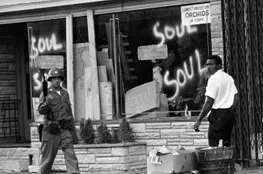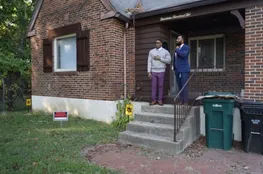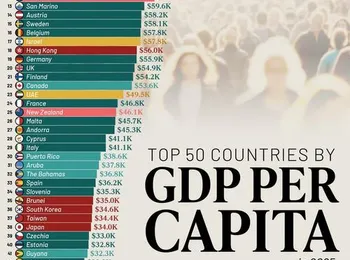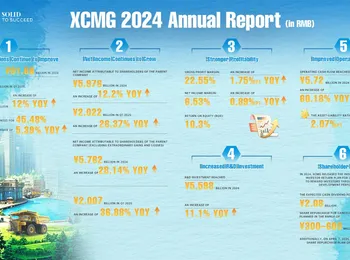Black economic life in America has continually been buffeted by external forces — slavery, Jim Crow, racial violence, redlining, urban renewal, and economic exclusion. But in the latter half of the 20th century, another layer of damage came from within. Urban Black communities, already reeling from systemic dispossession, began to experience spirals of crime, civil unrest, and illicit markets that further undermined the fragile business districts that had once been the pride of Black America. These pressures did not arise in a vacuum — they were rooted in concentrated poverty, segregation, disinvestment, and state abandonment. Yet their impact was undeniable: they hollowed out commercial corridors, weakened Black entrepreneurship, and left many neighborhoods resembling ‘failed nation states,’ marked by vacancy, disorder, and lost opportunity. The 1960s riots are the most visible example of internal shocks to Black business centers.
Following Martin Luther King Jr.’s assassination in 1968, Black corridors in Chicago (Madison Street), Washington, DC (14th and U Streets; H Street NE), and Baltimore (Pennsylvania Avenue) went up in flames. Hundreds of Black-owned businesses were destroyed, many never to return. Studies by economists William Collins and Robert Margo show that riots depressed property values in Black neighborhoods by double-digit percentages, with little rebound even decades later. Chicago’s West Side: More than 100 businesses along a two-mile stretch of Madison Street were lost in 1968. The corridor remained scarred by vacant lots for generations. Washington, DC: Along U Street and H Street NE, vacancies climbed above 70% in the 1970s. Economists have tracked block-level data showing persistent declines in property values in the riot zones. Detroit (1967) and Newark (1967): Similar patterns unfolded. Black-owned shops along Detroit’s 12th Street and Newark’s Springfield Avenue were destroyed. The physical destruction compounded already declining investment in these cities.
Black-owned shops along Detroit’s 12th Street and Newark’s Springfield Avenue were destroyed. The physical destruction compounded already declining investment in these cities. While many of these uprisings began as responses to police brutality, economic despair, and systemic injustice, their aftershocks often accelerated the collapse of once-vibrant business corridors. High crime rates became another internal drag on Black economic districts. As sociologist Robert Sampson has shown, violence concentrates in specific neighborhoods, reinforcing cycles of disinvestment. Rising homicide and robbery rates in the 1970s and 1980s drove both residents and customers away from Black business districts. High crime not only drove customers away but also invited more or over-policing. Over-policing, in turn, left more residents with criminal records, shrinking their chances for legitimate opportunities for employment or entrepreneurship. With fewer pathways to stable work, illicit markets became more attractive, deepening the cycle of crime, incarceration, and economic collapse.
Empirical studies confirm the connection: Steven Levitt and others found that every increase in reported crime drives measurable population flight. John Hipp’s research shows that violent and property crime directly raise the probability of business failure or relocation. In retail corridors, even a single incident could reduce customer foot traffic for weeks. The consequence was a feedback loop: fewer customers meant closures, closures meant fewer ‘eyes on the street,’ and vacant storefronts invited more disorder. As legitimate businesses faltered, illicit markets often took their place. The crack cocaine epidemic of the 1980s illustrates this dynamic vividly. In neighborhoods like Liberty City in Miami or parts of Harlem and South Central Los Angeles, drug economies displaced legal ones. The profits from narcotics drew young people away from traditional employment or entrepreneurship, while violence associated with the trade further destabilized business environments.
To understand this history, it is crucial not to reduce it to ‘Black-on-Black crime’ or self-destruction. Violence within Black neighborhoods has always been primarily a symptom of segregation, concentrated poverty, and exclusion from mainstream markets. The Bureau of Justice Statistics confirms that most crime is intraracial — whites largely commit violence against whites, Blacks against Blacks — because people offend where they live. The difference is that Black neighborhoods bore the added burden of systemic abandonment. The feedback loop looks like this: Disinvestment → illicit markets → rising violence → more policing → criminal records → fewer job opportunities → attraction to illicit economies → business closures → vacancy and disorder → further disinvestment. This cycle was not inevitable. It was the predictable result of a dual process: external oppression weakening the foundations of Black business life, and internal crises filling the vacuum left behind.
The destruction of Black economic business centers cannot be understood solely as the work of white supremacy, nor solely as the result of internal decay. It was the convergence of both. Systemic forces knocked Black businesses off balance, and then crime, riots, and illicit markets made recovery harder. By the late 20th century, the proud corridors of Madison Street in Chicago, U Street in Washington, Springfield Avenue in Newark, and Hough Avenue in Cleveland stood as shadows of their former selves. Ed Gaskin is Executive Director of Greater Grove Hall Main Streets and founder of Sunday Celebrations

